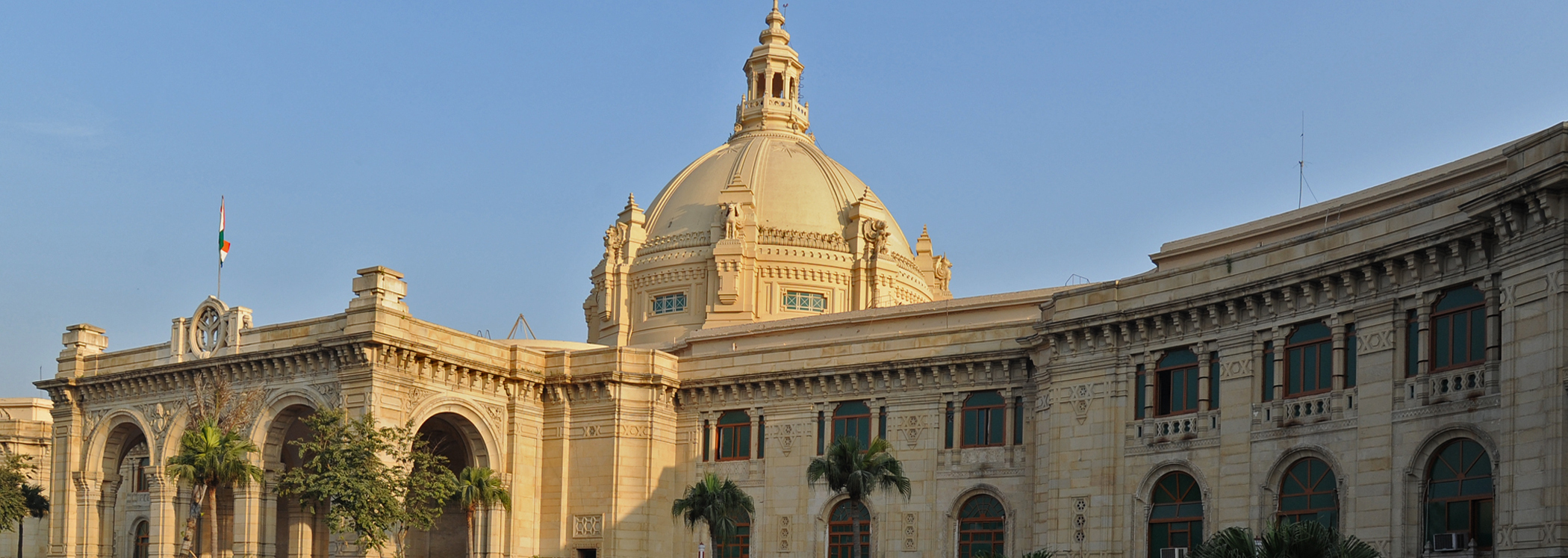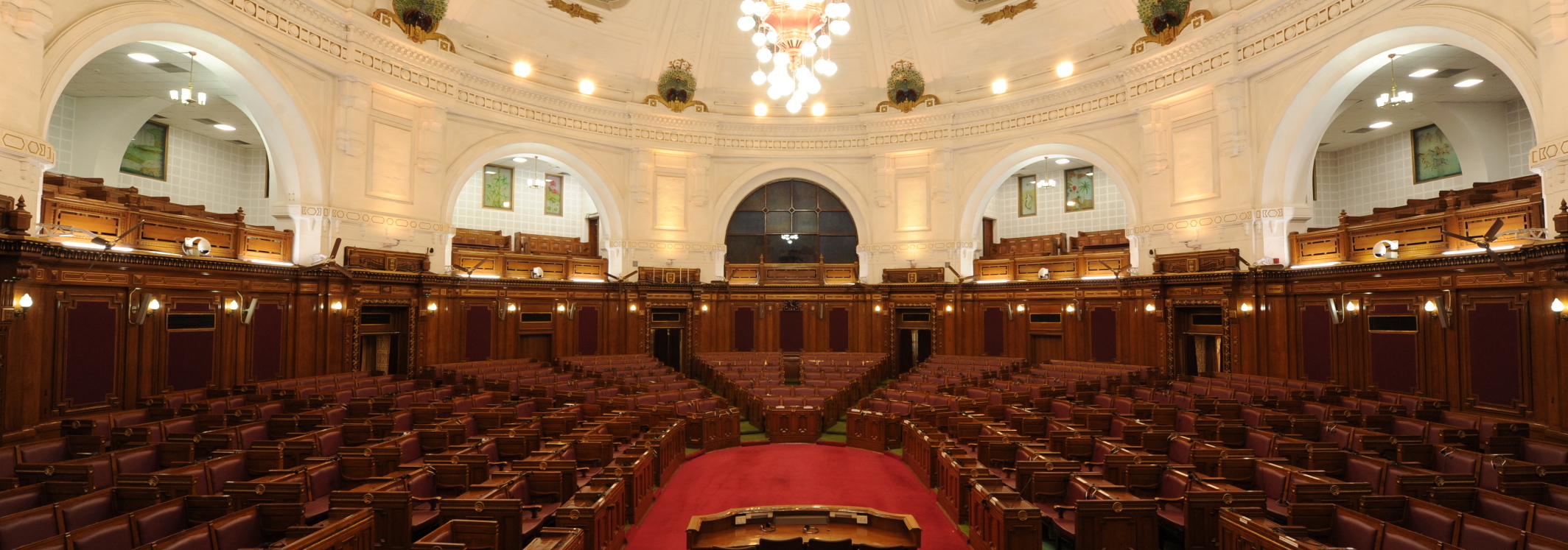About Us
Brief History
History of Legislature of Uttar Pradesh
The development of the legislative institutions in the State has a close connection with the history of legislature in India. Upto the year 1861, legislation was entirely in the hands of the British Parliament.
The Legislative Council of North Western Provinces and Oudh was constituted on 5th January, 1887, with nine nominated members. The Council met for the first time on 8th January, 1887 at the Thornhill Memorial Hall in Allahabad. By the Government of India Act, 1935, India was proposed to be made a federation of the provinces and princely states and autonomy was proposed for the provinces. The Legislative Council functioned as unicameral legislature in the State until March, 1937. The provincial part of the Act came into operation from April 1, 1937. The unicameral provincial legislature became bicameral alongwith five other provinces of British India. Then it came to consist of two "Chambers”-the “Legislative Assembly” and the "Legislative Council”. The Legislative Assembly, the Lower House, was a wholly elected body, while the Legislative Council, the Upper House, was partly elected and partly nominated. Meanwhile, the name of the State had become ‘United Provinces’.
Legislative Assembly in Pre-Independence Days
The introduction of provincial autonomy was a step in the direction of establishing the parliamentary form of government in the State. The Government of India Act, 1935 provided for the constitution of legislative Assembly with 228 elected members. The electoral system was based on the principle of communities, classes and other varied interests. The Assembly had a term of five years but the Governor could dissolve it at any time before the expiry of that period. It elected its own Speaker and Deputy Speaker.
Elections for the newly formed Assemblies were held all over the country before the introduction of the 1935 Act. For Uttar Pradesh Legislative Assembly, elections were held during December, 1936. The Congress party contested and secured a majority in nine provinces including Uttar Pradesh. The first Congress Ministry, headed by Pandit Govind Ballabh Pant, was formed in July, 1937. The first meeting of the Legislative Assembly was held on 29th July, 1937. Rajarshi Purushottam Das Tandon and Sri Abdul Hakim were elected the Speaker and the Deputy Speaker respectively on 31st July, 1937. The stalwarts, who were elected to this Assembly, were Acharya Narendra Dev, Charan Singh, Govind Ballabh Pant, Purushottam Das Tandon, Lai Bahadur Shastri, Mrs. Vijay Laxmi Pandit, Rafi Ahmad Kidwai and Nawabzada Mohammad Liyaqat Ali Khan and many others.
The first Assembly, constituted in pre-independence days, did not live long. On the outbreak of World War-ll on September 3, 1939, the Governor-General declared India to be in a state of war against Germany, without informing or consulting the representatives of the people in Central or Provincial legislatures. The G.B. Pant ministry could not associate itself with this British policy and resigned. As no alternative ministry, capable of commanding the confidence of Assembly, could be formed, the Governor finally suspended the Assembly.
In 1945, after the war, the Labour Party came to power in Britain and decided upon a fresh approach towards the Indian problems. The British Government entered into negotiations with Indian political leaders and decided to hold general elections in India, which were held in February and March, 1946.
The suspension of Legislature was cancelled by an order of the Governor on April 1, 1946. Pandit Govind Ballabh Pant was invited by the Governor to form the ministry. Pandit Pant accepted the invitation and the ministry headed by him was installed in office.
The newly elected Assembly met on April 25, 1946. Rajarshi Tandon was again elected Speaker on April 27, 1946. Sri Nafisul Hasan was elected the Deputy Speaker on August 15, 1946. In this Assembly an important resolution regarding the abolition of Zamindari system in Uttar Pradesh and asking the government to prepare a scheme for the purpose, was passed.
In the meantime the British Government recognised India’s right to complete independence and at the centre, a Constituent Assembly was set up which was followed by an interim government, consisting of accredited representatives of major parties. The British Government later on had decided to transfer power to the Indians. The Governor General, after consultations with important political leaders in India and subsequently with the approval of British Government, declared his plan for the transfer of power. On the basis of the plan, the Indian Independence Act was passed by the British Parliament in July and India became Independent on 15th August, 1947. After Independence the U.P Legislative Assembly met for the first time on November 3, 1947.
On February 25, 1948, the Assembly passed a resolution, regarding the amalgamation of the High Court of Judicature at Allahabad and the Oudh Chief Court. The year 1949 was marked by the introduction of two epoch making legislative measures, viz. The U.P Zamindari Abolition and Land Reforms Bill, 1949 and the U. P. Agricultural Tenants (Acquisition of Privileges) Bill, 1949, of which the latter was enacted in December, 1949 and the former in 1951.
India Becomes Republic
The Constituent Assembly, constituted on December 9, 1946, took about three years in framing the Constitution of free India and the new Constitution came into force on January 26, 1950, and India became a Sovereign Democratic Republic. India, however, remained within the British Commonwealth of Nations.
The first session of the provisional legislature of Uttar Pradesh under the new Constitution began on February 2, 1950. Hon’ble PD. Tandon was administered the oath of the office of Speaker. Hindi in Deonagri script was adopted as the official language. On 21st December, 1950, the Deputy Speaker, Sri Nafisul Hasan was elected the Speaker and Sri Hargovind Pant, the Deputy Speaker on January 4, 1951.
Legislative Assembly Under the Constitution of Free India
In the year 1952 millions of people in India went to the polls to exercise the democratic right granted to them by the Constitution of India to choose the country's legislators for the next five years. This was the biggest General Election on the basis of adult franchise ever held in the whole world. Under the provisions of the new Constitution, the strength of the U. P. Assembly was fixed at 431 which was revised to 426 later on including one nominated Anglo-Indian member. The term of the Legislative Assembly is five years unless dissolved earlier. Since then, it has been constituted for thirteen times.
At the commencement of the first session after each General Election to the Assembly and at the commencement of the first session of the year, the Governor addresses both the Houses of Legislature assembled together and informs the Legislature of the causes for summoning it. Both the Houses are summoned by the Governor from time to time.
The Speaker and Deputy Speaker are elected by the members of the Assembly from amongst themselves. They continue to hold office till they cease to be its Members or till they are removed from their office by a resolution of the House passed by a majority of all the then Members of the Assembly or till they themselves resign from their respective offices. The Speaker, however, continues to hold office even after the dissolution of the Assembly until immediately before the first meeting of the new Assembly.
The Legislature exercises effective control over the Executive as the latter is responsible to the former. In a democratic set-up like ours the Legislative Committees also have to play an important role. The Committee system started in the State with the evolution of the Legislature itself. The first Committee was constituted on 19th February, 1887, to examine the General Clauses Bill. After the establishment of a bicameral legislature and transfer of financial power from Legislative Council to Legislative Assembly, the two financial Committees, the Standing Finance Committee and the Public Accounts Committee went under the Legislative Assembly. There is provision for permanent, adhoc and Joint House Committees in the Rules of Procedure. At present, the House has many permanent Committees.
The Assembly, when summoned, meets in its Chamber in the Council House in the capital city of Lucknow. The Chamber of the House has a glory of its own. The chamber proper is octagonal with a dome-shaped roof, decorated at intervals with stucco peacocks, having wings and tails extended.
Both the Houses of the Legislature have separate secretariat with a Principal Secretary as the head. They are independent of the Government. There is a well equipped computerised Library with Research, Reference and Documentation Services for use of the Members of both the Houses. It is reportedly one of the biggest and richest legislature library of India.
Building
Vidhan Bhawan
The foundation stone of the grand building of the Council House (Vidhan Bhawan) was laid by the then Governor Sir Spencer Harcourt Butler on 15th December, 1922 and the building was inaugurated on 21st February, 1928. The construction of the building was done by Messrs Martin and Co. The Chief Architects were Sir Swinon Jacob and Sri Heera Singh. At that time a sum of Rs. 21 Lakhs was sanctioned for the building. The building is one of the finest examples of Indo-European architectural craftsmanship of the twentieth century. The front part of this crescent shaped two storeyed structure is built with carved light brown sandstone blocks from Mirzapur (Chunar). At the centre of the crescent is a large Gothic dome with an attractive “Chhatry” or sky light. Figures sculpted from stone blocks surround the facade of the dome. Above the tri-arched front of the portico is placed the State emblem (crest) carved in marble.
Many of the inside halls, galleries and verandahs are built of Agra and Jaipur marble. Beautiful circular marble staircases run on both sides of the entrance hall. The walls of these staircases have now been embellished with beautiful paintings.
The dome shaped Chamber is octagonal and it's circular roof is decorated in attractive inlay-work. A unique feature are the beautiful figures of dancing peacocks decorated at intervals on this roof. The sittings of the Legislative Assembly are held in this hall. There are large lobbies for Members on both sides of this hall.
In July, 1935 a proposal for construction of a new Chamber and office rooms for the new Legislative Council was made and the construction was entrusted to Messrs Ford and Macdonald. Under the supervision of the Public Works Department the extension was completed by Chief Architect A.L. Mortimer in 1937. The building of the Legislative Council is connected to the main Vidhan Bhawan building by verandahs with rooms on both sides. The sittings of the Legislative Council are held here.




